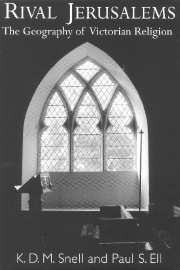Book contents
- Frontmatter
- Contents
- List of figures
- List of tables
- Preface and acknowledgements
- Introduction
- Part 1 Religious geographies: the districts of England and Wales
- Part 2 Religion and locality: parish-level explorations
- Technical appendices
- A Denominational statistics
- B The correction of census data
- C The religious measures
- D Computer cartographic methods
- E Landownership and the Imperial Gazetteer
- F An 1861 Census of Religious Worship?
- Bibliography
- Index
E - Landownership and the Imperial Gazetteer
Published online by Cambridge University Press: 08 August 2009
- Frontmatter
- Contents
- List of figures
- List of tables
- Preface and acknowledgements
- Introduction
- Part 1 Religious geographies: the districts of England and Wales
- Part 2 Religion and locality: parish-level explorations
- Technical appendices
- A Denominational statistics
- B The correction of census data
- C The religious measures
- D Computer cartographic methods
- E Landownership and the Imperial Gazetteer
- F An 1861 Census of Religious Worship?
- Bibliography
- Index
Summary
There has been use at various points in this book of the parish landownership classifications taken from the Imperial Gazetteer. This impressive source provided data for this book on divisions of landed property, types of ecclesiastical living, value of ecclesiastical livings, whether those livings included accommodation for the incumbent, and real property values. It categorised parishes into four groups according to their landownership: held in one hand; not much divided or in few hands; sub-divided; and much sub-divided. This was evidently a simple classification, a guide to one salient feature of the parish or township being described, and it has been used by earlier historians as well as ourselves. It is well suited to the kinds of quantitative analyses pursued here. Almost no information was given in different editions of the Imperial Gazetteer about how its landownership divisions were arrived at, and contemporary readers seem to have taken those classifications as being relatively straightforward. By that time (with all the debate there had been on settlement and ‘open’ and ‘close’ parishes, and in 1867–9 on the gang system and female and child agricultural labour), they were well accustomed to thinking about parishes in such terms.
Despite some historians' prior use of the Gazetteer, and some preliminary tests with very limited numbers of parishes, there has been no rigorous examination of how reliable its coverage and classifications were.
- Type
- Chapter
- Information
- Rival JerusalemsThe Geography of Victorian Religion, pp. 440 - 448Publisher: Cambridge University PressPrint publication year: 2000



